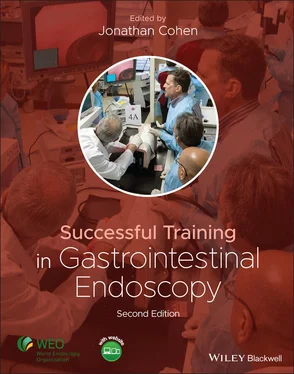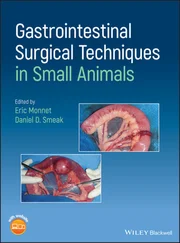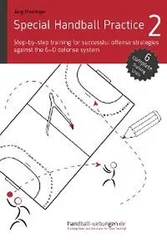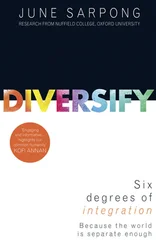Successful Training in Gastrointestinal Endoscopy
Здесь есть возможность читать онлайн «Successful Training in Gastrointestinal Endoscopy» — ознакомительный отрывок электронной книги совершенно бесплатно, а после прочтения отрывка купить полную версию. В некоторых случаях можно слушать аудио, скачать через торрент в формате fb2 и присутствует краткое содержание. Жанр: unrecognised, на английском языке. Описание произведения, (предисловие) а так же отзывы посетителей доступны на портале библиотеки ЛибКат.
- Название:Successful Training in Gastrointestinal Endoscopy
- Автор:
- Жанр:
- Год:неизвестен
- ISBN:нет данных
- Рейтинг книги:3 / 5. Голосов: 1
-
Избранное:Добавить в избранное
- Отзывы:
-
Ваша оценка:
- 60
- 1
- 2
- 3
- 4
- 5
Successful Training in Gastrointestinal Endoscopy: краткое содержание, описание и аннотация
Предлагаем к чтению аннотацию, описание, краткое содержание или предисловие (зависит от того, что написал сам автор книги «Successful Training in Gastrointestinal Endoscopy»). Если вы не нашли необходимую информацию о книге — напишите в комментариях, мы постараемся отыскать её.
Teaches trainee gastroenterologists the endoscopic skills needed to meet the medical training requirements to practice gastroenterology and helps clinical specialists refresh their skills to pass their recertification Successful Training in Gastrointestinal Endoscopy, Second Edition
Successful Training in Gastrointestinal Endoscopy, Second Edition
Successful Training in Gastrointestinal Endoscopy — читать онлайн ознакомительный отрывок
Ниже представлен текст книги, разбитый по страницам. Система сохранения места последней прочитанной страницы, позволяет с удобством читать онлайн бесплатно книгу «Successful Training in Gastrointestinal Endoscopy», без необходимости каждый раз заново искать на чём Вы остановились. Поставьте закладку, и сможете в любой момент перейти на страницу, на которой закончили чтение.
Интервал:
Закладка:
The concept of cognitive overload during endoscopy also illustrates the importance of using specific learning objectives at an appropriate level of difficulty for the learner. Learning activities should be focused on simple, well‐defined, and achievable points. Using a stepwise educational program can be useful since as each new skill is acquired, gradual introduction of progressively more difficult components of each task becomes easier as they build on prior successes [16]. Ideally, these steps are acquired along with conscious understanding of the steps and how they were taught, allowing the trainee to become a future trainer. This “progressive” learning approach can also be incorporated into simulation‐based training ( Figure 2.1).
Overcoming obstacles
This section refers to difficulties that can be encountered in a variety of aspects of endoscopic procedures. Strategies to navigate across sphincters, around sharp curves, and through areas of resistance typically require achievement of a basic level of competence in navigation prior to attempting to master these challenges. Novice endoscopists typically struggle with traversing the pylorus if they have not mastered when to use small amounts of tip deflection rather than large movements via torque application in order to generate rotation of the scope upon its long axis for example. Another area of uncertainty for trainees is how much resistance is normal, such as when encountering paradoxical scope movement. This becomes particularly important when traversing strictures or altered anatomy (e.g., advanced diverticular disease in colonoscopy, Billroth II anastomosis in ERCP, etc.). Again, this requires both attention to a cognitive component and a technical component of training. Although it may technically be possible to traverse a malignant stricture, clearly consideration must first be given in training to the potential advantages and disadvantages of other modalities or approaches before this is attempted. A similar analogy applies to the difficult cannulation during ERCP. A trainee can too easily become consumed with technical efforts to overcome the obstacle and must not lose sight of the relative indications for persistence as the procedure proceeds. What may seem obvious and commonplace to an experienced endoscopist may not be known or understood by trainees. This also highlights the importance of checking understanding with trainees during endoscopic training, particularly if the trainee is new to the trainer.
Recognition and prevention of difficulties are a major component of ensuring patient safety and comfort. This may require using a lower setting of air insufflation for instance or defining the amount of the procedure that should be performed by trainees (e.g., limiting polypectomy, sphincterotomy, or other therapeutic steps until the preliminary diagnostic skills have been mastered). This emphasizes the importance of establishing clear limits on what the trainee is expected to do during a procedure and when the trainer will take over the procedure. By doing this, the teacher will manage the emotional aspects of learning better and avoid the negative connotation of taking over a procedure. The other important components of training (covered in the Chapter 3) include the medicolegal aspects, appropriate informed consent, and so on.
Inspection
Once the scope has been advanced to the desired limit, and that location has been confirmed in some way, the next step is to carefully withdraw the scope while thoroughly examining the entire mucosal surface. This requires essentially the same skills as in scope navigation. Again, although this can be viewed as a technical component, there is no doubt that cognition plays an important role. Detection of specific lesions, such as the findings of celiac disease, eosinophilic esophagitis, and so on, is more related to an awareness of what is being looked for rather than being solely based upon technique. This is particularly relevant to endoscopic reporting, in which a thorough description of tumor characteristics and relation to landmarks may have great implications for the surgical approach for instance, and a repeat endoscopy will be required if communication between endoscopist and the surgeon is not sufficiently specific and detailed. Training in the cognitive aspects of image interpretation and assessment can be developed by didactic resources such as review of atlases and by direct mentored experience. The development of such cognitive skills should occur at the same time that the trainee learns to carefully inspect the entire mucosa, as these skills are complementary and dependent on one another.
The technical requirements of inspection differ somewhat depending on the nature of the procedure. In upper endoscopy, for example, the papilla and medial wall of the duodenum are common blind spots without careful and deliberate inspection, and may not always be easily obtained during EGD. In EUS or ERCP, the oblique viewing nature of the endoscope provides particular limitations and careful attention must be paid. In EUS imaging, the ultrasound view has very specific requirements to ensure that adequate imaging of specific structures has occurred. Depending on the indication for the procedure, repositioning of the patient, addition of fluid in the lumen, removing mucous, using chromoendoscopy, or narrow‐band imaging may be particularly useful. For enteroscopy or colonoscopy, inspection is a crucial aspect that has been highlighted by recent trials of adenoma detection. Slow withdrawal of the endoscope must be achieved, while at the same time using frequent movement of the tip of the endoscope to ensure that the entire circumference of the mucosa is inspected. Proper insufflation is helpful in effacing the mucosa, making polyps more easily identified. In several areas, repositioning of the patient may also be useful. Care must be taken to avoid rapid expulsion of the scope as this may occur when the tip of the endoscope is not anchored in place. To avoid unintended sudden changes in endoscope position, careful attention to both the endoscopic image and sensation in the right hand is necessary. Scope readvancement may be required if a region of the wall is not seen on first pass. Flexures and folds in the colon may create potential blind spots in colonoscopy for instance, or in the case of EUS, there are known blind spots in the stomach or regions that are outside of the limit of the ultrasound image. The endoscopist must always be aware of these locations and ensure that they are properly evaluated. Complete examination of specific areas within the GI tract, such as the distal rectum and anorectal junction, requires the endoscopist to be able to retroflex the endoscope in the rectum. This may also be required for complex polypectomy or other therapeutic maneuvers elsewhere in the GI tract. In the upper GI tract, for example, complete inspection of the stomach requires the endoscopist to be able to retroflex the scope to provide a complete view of the cardia and fundus. Retroflexion requires the endoscopist to understand the concept of paradoxical movement; as the retroflexed scope is withdrawn, the tip gets closer to the esophagogastric junction. Once the scope is retroflexed, the endoscopist can more accurately view the entire lesser curvature with a good view of the incisura angularis and the proximal lesser curvature. The hiatal opening can be viewed from below, and lesions in the cardia and fundus can be accurately evaluated. The combination of retroflexion, withdrawal of the scope, and rotation are required to fully evaluate the stomach.
Assessment of mucosal inspection can be done in terms of the percent of mucosal surface evaluated. This is best done using virtual reality simulators, where these metrics are readily obtained electronically. A skilled endoscopist can achieve this more efficiently than a novice, but it must be emphasized that quick endoscopy that does not provide complete mucosal inspection is a poor trade‐off. At the present time, documentation of imaging quality in lower GI procedures typically involves photo or video documentation of specific landmarks such as the terminal ileum, ileocecal valve, and appendiceal orifice. In addition, aspects such as bowel preparation and residual bodily fluids may impair visualization of subtle lesions, and trainees should be encouraged to evaluate and document their presence. In endoscopic ultrasound, training should give consideration to the evaluation and documentation of the adequacy of examination on an intent‐to‐image basis.
Читать дальшеИнтервал:
Закладка:
Похожие книги на «Successful Training in Gastrointestinal Endoscopy»
Представляем Вашему вниманию похожие книги на «Successful Training in Gastrointestinal Endoscopy» списком для выбора. Мы отобрали схожую по названию и смыслу литературу в надежде предоставить читателям больше вариантов отыскать новые, интересные, ещё непрочитанные произведения.
Обсуждение, отзывы о книге «Successful Training in Gastrointestinal Endoscopy» и просто собственные мнения читателей. Оставьте ваши комментарии, напишите, что Вы думаете о произведении, его смысле или главных героях. Укажите что конкретно понравилось, а что нет, и почему Вы так считаете.












